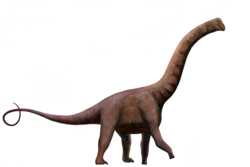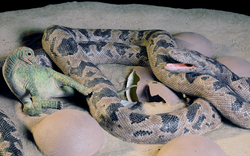Top Qs
Timeline
Chat
Perspective
Lameta Formation
Geologic formation in India From Wikipedia, the free encyclopedia
Remove ads
The Lameta Formation, also known as the Infratrappean Beds (not to be confused with the contemporaneous Intertrappean Beds), is a sedimentary geological formation found in Madhya Pradesh, Gujarat, Maharashtra, Telangana, and Andhra Pradesh, India, associated with the Deccan Traps.[1] It is of the Maastrichtian age (Late Cretaceous), and is notable for its dinosaur fossils.
Remove ads
History
The first fossils found in the Lameta Formation were discovered between 1917 and 1919.[2]
The Lameta Formation was first identified in 1981 by geologists working for the Geological Survey of India (GSI), G. N. Dwivedi and Dhananjay Mahendrakumar Mohabey, after being given limestone structures–later recognised as dinosaur eggs–by workers of the ACC Cement Quarry in the village of Rahioli near the city Balasinor in the Gujarat state of western India.[3]
Remove ads
Lithology

The formation is underlain by the Lower Cretaceous sedimentary "Upper Gondwana Sequence" also known as the Jabalpur Formation, and is overlain by the Deccan Traps basalt. The Lameta Formation is only exposed at the surface as small isolated outcrops associated with the Satpura Fault. The lithology of the formation, depending on the outcrop, consists of alternating clay, siltstone and sandstone facies, deposited in fluvial and lacustrine conditions. The environment at the time of deposition has alternatively been considered semi-arid, or tropical humid.[4][5]
Remove ads
Fossil content
Summarize
Perspective
Many dubious names have been created for isolated bones, but several genera of dinosaurs from these rocks are well-supported, including the titanosaur sauropods Isisaurus and Jainosaurus and the Abelisaurs Indosaurus, Indosuchus, and Rajasaurus and Noasaurids Laevisuchus.[6] Synapsids are also known form the formation, such as the possibly late surviving Avashishta,possibly the last known non- mammalian synapsid the possibly youngest known stegosaurian ichnogenus Deltapodus, madtsoiid snakes and other fossils.
Dinosaurs

Color key
|
Notes Uncertain or tentative taxa are in small text; |
Ornithischians
Sauropods
Theropods
Abelisaurs
Noasaurids
Other Theropods
Indeterminate or chimaeric taxa
Reptiles
Snakes
Crocodylomorphs
Turtles
Mammals
Mollusca
Remove ads
See also
- List of dinosaur-bearing rock formations
- Geology of India
- Deccan Traps
- Maevarano Formation, contemporaneous fossiliferous formation of Madagascar
- Intertrappean Beds contemporaneous formation in India, also known for its fossils
References
Wikiwand - on
Seamless Wikipedia browsing. On steroids.
Remove ads










